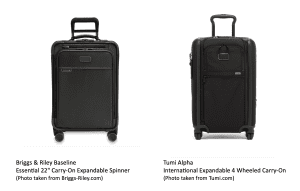When it comes to premium luggage, Briggs & Riley vs. Tumi is one of the most debated comparisons among frequent travelers. As a pilot, I have gone through my fair share of suitcases over the years. If you buy cheap suitcases you will end up throwing them away when they get damaged and the cycle will continue if you keep buying cheap suitcases. However, buying a quality suitcase may seem a bit much at first, but in the long run you will see the long term benefits. Both of my Briggs & Riley and Tumi cases have lasted me over 10 years. Both brands offer high-quality, durable, and functional suitcases, but they differ in key areas such as design, warranty, and price. If you’re considering investing in a new carry-on, this comparison will help you determine which brand suits your travel style best.
Briggs & Riley Baseline Series
$699.00
Baseline Essential 22″ Carry-On Spinner as the ultimate domestic carry-on, built with the incomparable Briggs & Riley construction that guarantees enduring performance.


Tumi Alpha Series
$895.00
Built to power you through weekend getaways and international travels, this FXT® ballistic nylon carry-on brings together innovative design, superior performance and best-in-class functionality.
1. Durability and Materials
Briggs & Riley Essential 22″ Carry-On: Made with 1680D ballistic nylon, resistant to wear, water, and abrasion.
Tumi Alpha International Dual Access Carry-On: Features FXT® ballistic nylon, providing durability with a more refined aesthetic.
Both suitcases are built to last, but Briggs & Riley’s fabric is slightly lighter, whereas Tumi’s material offers a sleeker look with comparable durability.
2. Expandability and Packing Space
Briggs & Riley: Uses CX™ Compression-Expansion Technology, allowing expansion by up to 25% and compressing back to the original size.
Tumi: Features Dual Access design, enabling front-lid access and split case packing, but it does not compress back like B&R’s CX system.
Briggs & Riley maximizes packing capacity with its compression system, making it ideal for travelers needing extra space.
3. Handle and Maneuverability
Briggs & Riley: Uses an Outsider Handle System, meaning the handle is on the exterior, creating a flat interior for more packing space.
Tumi: Uses an integrated telescoping handle, which reduces available packing space but provides a sleek, premium feel.
If maximizing interior space is important, Briggs & Riley wins here. Tumi’s handle feels more refined but sacrifices some packing efficiency.
4. Warranty and Long-Term Value
Briggs & Riley: Lifetime Warranty—covers all repairs, even airline damage.
Tumi: 5-Year Limited Warranty, but it does not cover airline damage.
Warranty and long-term value is very important for a suitcase. Briggs & Riley’s industry-leading warranty policy makes it the better long-term investment as Tumi only offers a 5 year warranty compared to the lifetime warranty from B&R.
5. Tech Features & Extras
Briggs & Riley: Focuses on function and durability over extra tech.
Tumi: Includes a built-in USB port and Tumi Tracer® for tracking lost luggage.
Tumi offers more modern travel tech, making it appealing to business travelers who value convenience.
6. Price & Value
Briggs & Riley Essential 22″: $699
Tumi Alpha International Dual Access Carry-On: $895
Tumi carries a premium price tag but offers high-end aesthetics and brand prestige. Briggs & Riley, while slightly more affordable, offers superior warranty coverage, making it a better value for long-term travelers.
Final Verdict: Which One Should You Choose?
I love both of my Briggs & Riley and Tumi cases. It’s hard to side with one. However, if you prioritize functionality, durability, lifetime warranty, and maximum packing space, the choice for me would be the B&R. However, if you want a sleeker, luxury aesthetic with tech-friendly features like USB charging and luggage tracking then Tumi is the way to go.
It’s been my experience as a pilot that most frequent travelers prefer the Briggs & Riley as it is the smarter investment due to its compression system, superior warranty, and greater packing efficiency. However, if you prefer tech integrations and a polished luxury feel, Tumi remains a solid competitor.
Let me know what your thoughts are and shoot me a note! I would love to hear from my readers.
The Nomad Pilot









